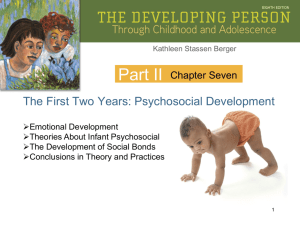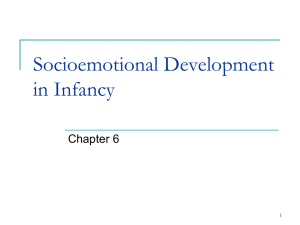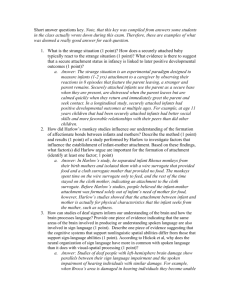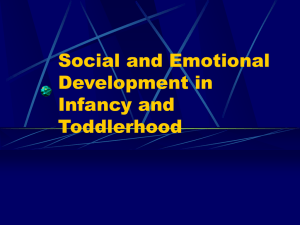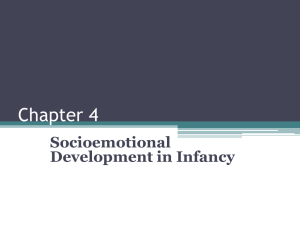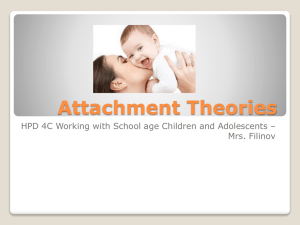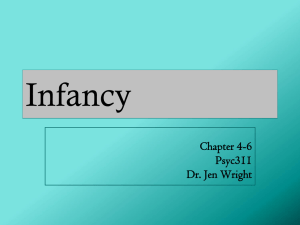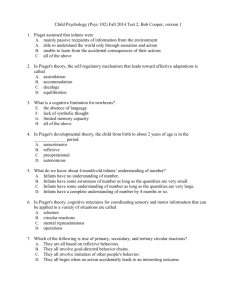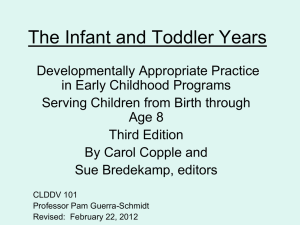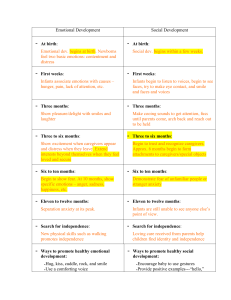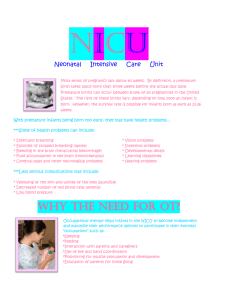Emotional Development
advertisement
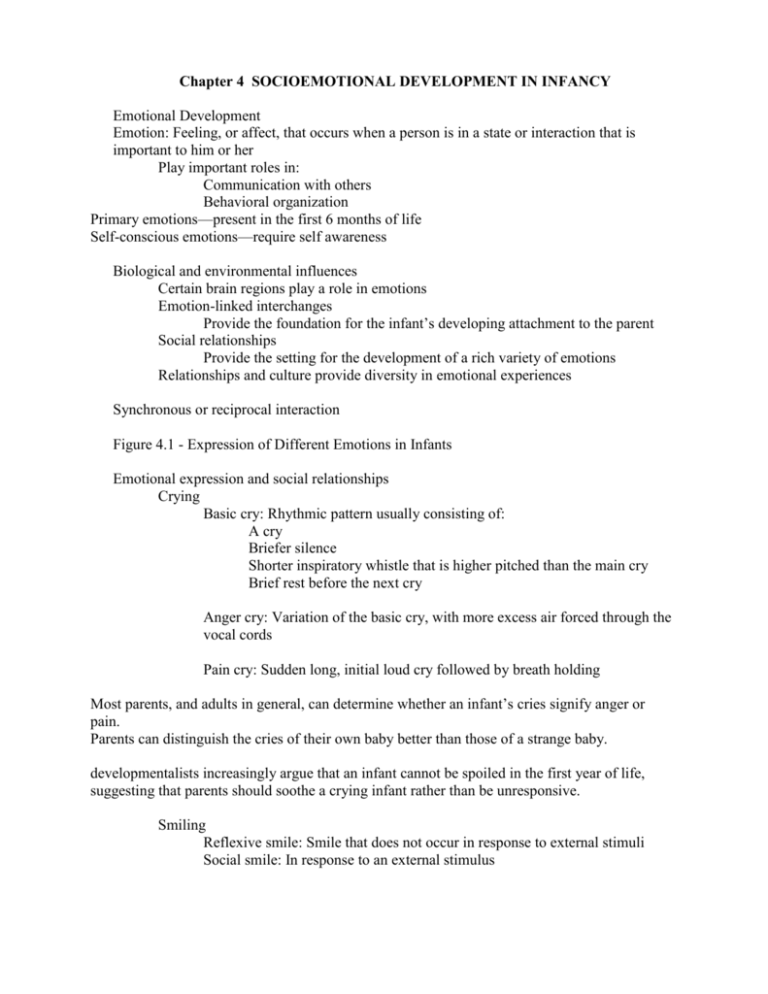
Chapter 4 SOCIOEMOTIONAL DEVELOPMENT IN INFANCY Emotional Development Emotion: Feeling, or affect, that occurs when a person is in a state or interaction that is important to him or her Play important roles in: Communication with others Behavioral organization Primary emotions—present in the first 6 months of life Self-conscious emotions—require self awareness Biological and environmental influences Certain brain regions play a role in emotions Emotion-linked interchanges Provide the foundation for the infant’s developing attachment to the parent Social relationships Provide the setting for the development of a rich variety of emotions Relationships and culture provide diversity in emotional experiences Synchronous or reciprocal interaction Figure 4.1 - Expression of Different Emotions in Infants Emotional expression and social relationships Crying Basic cry: Rhythmic pattern usually consisting of: A cry Briefer silence Shorter inspiratory whistle that is higher pitched than the main cry Brief rest before the next cry Anger cry: Variation of the basic cry, with more excess air forced through the vocal cords Pain cry: Sudden long, initial loud cry followed by breath holding Most parents, and adults in general, can determine whether an infant’s cries signify anger or pain. Parents can distinguish the cries of their own baby better than those of a strange baby. developmentalists increasingly argue that an infant cannot be spoiled in the first year of life, suggesting that parents should soothe a crying infant rather than be unresponsive. Smiling Reflexive smile: Smile that does not occur in response to external stimuli Social smile: In response to an external stimulus Fear Stranger anxiety: Fear and wariness of strangers Separation protest: Distressed crying when the caregiver leaves It tends to appear in the second half of the first year of life, intensifying and escalating around 9 months of age. Peaks around 15 mo in US infants; When infants have a sense of security, through familiar settings and physical proximity to parent-- less likely to show stranger anxiety. Social referencing: “Reading” emotional cues in others to help determine how to act in a particular situation Emotional regulation and coping—develop ability to inhibit or minimize the intensity and duration of emotional reactions. Soothing themselves Caretakers responses Caregivers’ actions and contexts can influence emotional regulation Soothing a crying infant helps infants develop a sense of trust and secure attachment to the caregiver Temperament Individual differences in behavioral styles, emotions, and characteristic ways of responding Describing and classifying temperament Chess and Thomas’ classification Easy child: Generally in a positive mood Quickly establishes regular routines in infancy Adapts easily to new experiences Difficult child: Reacts negatively and cries frequently Engages in irregular daily routines Slow to accept change Slow-to-warm-up child: Low activity level Somewhat negative Displays a low intensity of mood Jerome Kagan: labels temperament as inhibition; behavioral inhibition Effortful Control (Self-Regulation) - Rothbart and Bates’ classification Extraversion/surgency Negative affectivity Effortful control Biological foundations and experience Biological influences Gender, culture, and temperament Parents may react differently to an infant’s temperament depending on gender Cultural differences in temperament were linked to parent attitude and behaviors Goodness of fit: Match between a child’s temperament and the environmental demands the child must cope with Strategies for temperament-sensitive parenting: Attention to and respect for individuality Structuring the child’s environment Avoid applying negative labels to the child Personality Development Trust: According to Erik Erikson, the first year of life is characterized by the trust-versusmistrust stage of development. Erikson believed that infants learn trust when they are cared for in a consistent, warm manner. If the infant is not well fed and kept warm on a consistent basis, a sense of mistrust will develop. The Developing Sense of Self Infants are not “given” a self by their parents or the culture, rather they find and construct selves. Independence Erikson described the second developmental stage as autonomy versus shame and doubt. This covers ages 1 to 3 Autonomy builds on the infant’s developing mental and motor abilities. Infants feel pride in their new accomplishments (such as climbing, pushing, pulling, etc.). They want to do everything themselves so important for parents to recognize the motivation of toddlers to do what they are capable of doing at their own pace. When parents consistently overprotect or criticize toddlers, children develop an excessive sense of shame and doubt about their ability to control themselves and their world. Attachment: Close emotional bond between two people Freud - Infants become attached to the person that provides oral satisfaction Harlow - Contact comfort preferred over food Harlow and Zimmerman study found that feeding is not the crucial element in the attachment process and that contact comfort is very important. Erikson believed that the first year of life is the key time frame for the development of attachment. John Bowlby believes that the newborn is biologically equipped to elicit the attachment behavior from the primary caregiver. Bowlby - Four phases of attachment Phase 1: From birth to 2 months - Attachment to human figures Phase 2: From 2 to 7 months - Focus on one figure Phase 3: From 7 to 24 months - Specific attachments develop Phase 4: From 24 months on - Become aware of others’ feelings Individual Differences in Attachment Strange situation: Observational measure of infant attachment Requires the infant to move through a series of: Introductions Separations Reunions with the caregiver and an adult stranger in a prescribed order Securely attached babies: Use the caregiver as a secure base from which to explore the environment Insecure avoidant babies: Avoiding the caregiver Insecure resistant babies: Cling to the caregiver, then resist the caregiver by fighting against the closeness Insecure disorganized babies: Being disorganized and disoriented Disorganized babies are dazed, confused, and fearful. Caregiving Styles and Attachment Maternal sensitivity linked to secure attachment Caregivers of insecurely attached infants tend to be: Rejecting Inconsistent Abusive Caregivers of securely attached babies are sensitive to their signals and are consistently available to respond to their infants’ needs. Caregivers of avoidant babies tend to be unavailable or rejecting, tending not to respond to their babies’ signals and having little physical contact with them. Caregivers of resistant babies sometimes respond to their babies’ need and sometimes do not. Caregivers of disorganized babies often neglect or physically abuse their babies, and sometimes these caregivers suffer from depression Social Contexts The family Figure 4.9 - Interaction Between Children and their Parents: Direct and Indirect Effects Constellation of subsystems Transition to parenthood New parents face disequilibrium and must adapt to it Reciprocal socialization: Bidirectional Children socialize parents, just as parents socialize children The behaviors of mothers and infants involve substantial interconnection, mutual regulation, and synchronization. Scaffolding: Parents time interactions so that infants experience turn taking with the parents Managing and guiding infants’ behavior Being proactive and childproofing the environment Engaging in corrective methods Maternal and paternal caregiving Fathers have the ability to act sensitively and responsively with their infants as mothers do. Paternal interactions are more likely to include play. Fathers engage in more rough-and-tumble play, while mothers’ play is less physical. Maternal interactions usually center around child- care activities- Feeding, changing diapers, bathing In stressful circumstances, infants show a stronger attachment to their mother. Figure 4.8 - The Increase in the Number of U.S. Fathers Staying at Home Full-Time with their Children Child Care Far more young children are in day care today than at any other time in history. Many US children experience multiple caregivers Unlike many European countries, the United States does not have a policy of paid leave for child care, thus day care has become a major national concern. Variations in child care Parental leave Factors that influence the Child Care effects are: Age of the child Type of child care Quality of the program Strategies parents can follow: Recognize that the quality of your parenting is a key factor in your child’s development Make decisions that will improve the likelihood that you will be good parents Monitor your child’s development Take some time to find the best child care
